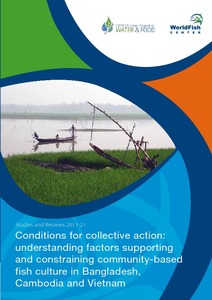Resource information
Flood-prone ecosystems in South and Southeast Asia are traditionally farmed with deepwater rice followed by post-flood rice culture during the dry season. During the
flood season, the same land is inundated, creating an open-access water body subject to multiple uses by multiple users. Fish production in these areas is based on
the capture of wild fish. In these seasonal flood plains, fish are trapped in rice fields, reproduce and are harvested by farmerfishers or full-time fishers. These flooded areas cover about 4.5 million hectares in Bangladesh, and 1.2-1.4 million hectares
(Catling 1992) is deeply flooded in the Mekong Delta of Vietnam and Cambodia for 4 to 6 months each year. One option to improve access to protein and diversified income for local users
and to improve water-use efficiency is to integrate fish culture into this system. A number of studies conducted in the 1980s tested the technical feasibility of culturing
fish in seasonally flooded rice fields (Roy et al. 1990, Mukhopadhyay et al. 1992, Rothuis et al. 1998a, Rothuis et al. 1998b, Ali et al. 1998). These studies showed that
fish production could be increased by more than 1 ton per hectare per year (t/ha/yr) by stocking fish in flooded rice fields in individual plots. Based on these findings, the WorldFish
Center implemented between 1997 and 2000 on-farm experimental trials of community-based fish culture (CBFC) on the Ganges and Meghna floodplains of Bangladesh and the Red River and
Mekong deltas in Vietnam (WorldFish 2002). Farms are cultivated individually during the dry season, but during the flood season individual landholding boundaries
disappear under the water, and water bodies and flooded rice field resources become common property. The project was based on the premise that production from these water bodies could be enhanced
by stocking locally important fish species, providing communities with an additional source of income and an increased supply of affordable fish for sale or consumption
(e.g., Dey and Prein 2003, IIRR 2000, Sinhababu et al. 1984). The results showed that fish production can be increased, with an average of 226 kilograms (kg)/ha in
Vietnam and 863 kg/ha in Bangladesh, with a significant improvement of the household income (Dey et al. 2005). CBFC was found technically and economically sound and
socially acceptable. However, the project concluded that further research was needed to understand how the institutional mechanisms needed to support fish culture
differ in a range of different contexts. From 2005 to 2010, the Challenge Program on Water and Food project Communitybased Fish Culture in Seasonal Floodplains
developed a series of trials to test this technology under different environmental and socioeconomic conditions. The objective of the project was to test the feasibility of this
approach to improve water-use efficiency and provide benefits to the various users of seasonally flooded rice fields. Technical and economic aspects were monitored, and
locally appropriate group arrangements for fish culture management, benefit sharing and resource access were tested. Although the technical and environmental aspects of culture-based fisheries in
various countries are well documented (De Silva 2003, Nguyen et al. 2001, De Silva etal. 2006), CBFC in seasonal floodplains is a relatively new concept, and the suitability
of this approach in different contexts remains under question. The project aimed to address this issue by developing onfarm trials in seasonally flooding areas with
otherwise contrasting socioeconomic and natural environments. In this report, we focus on a study designed to understand the factors and conditons that support or constrain the feasibility and
uptake of community-based fish culture in seasonal floodplains. The aim of the study is to contribute to knowledge on institutions for collective action, and the feasibility of
community-based approaches to resource management, based on lessons learned in this 5-year project. The study also offers useful lessons for project implementation
in the field of research-for-development. The report begins with an introduction to the Community-based Fish Culture project and a description of the technical intervention.
The second part of the report introduces the study to investigate the conditions for collective action in community-based fish culture, beginning with a presentation of
the research approach and methodology. The third section presents the findings of the study. Finally, we present a synthesis of the factors supporing and constraining
community-based fish culture, key lessons learned and recommendations.



